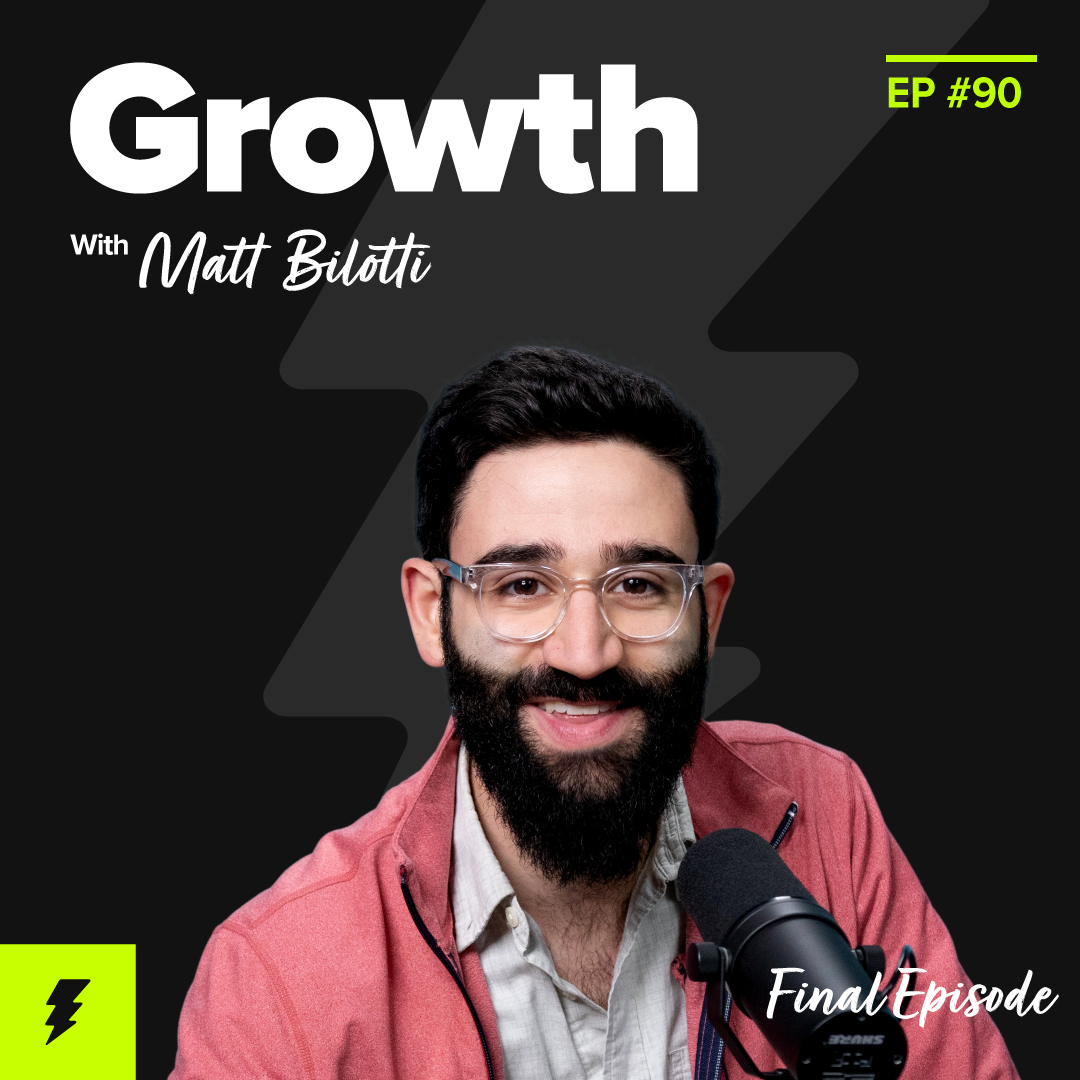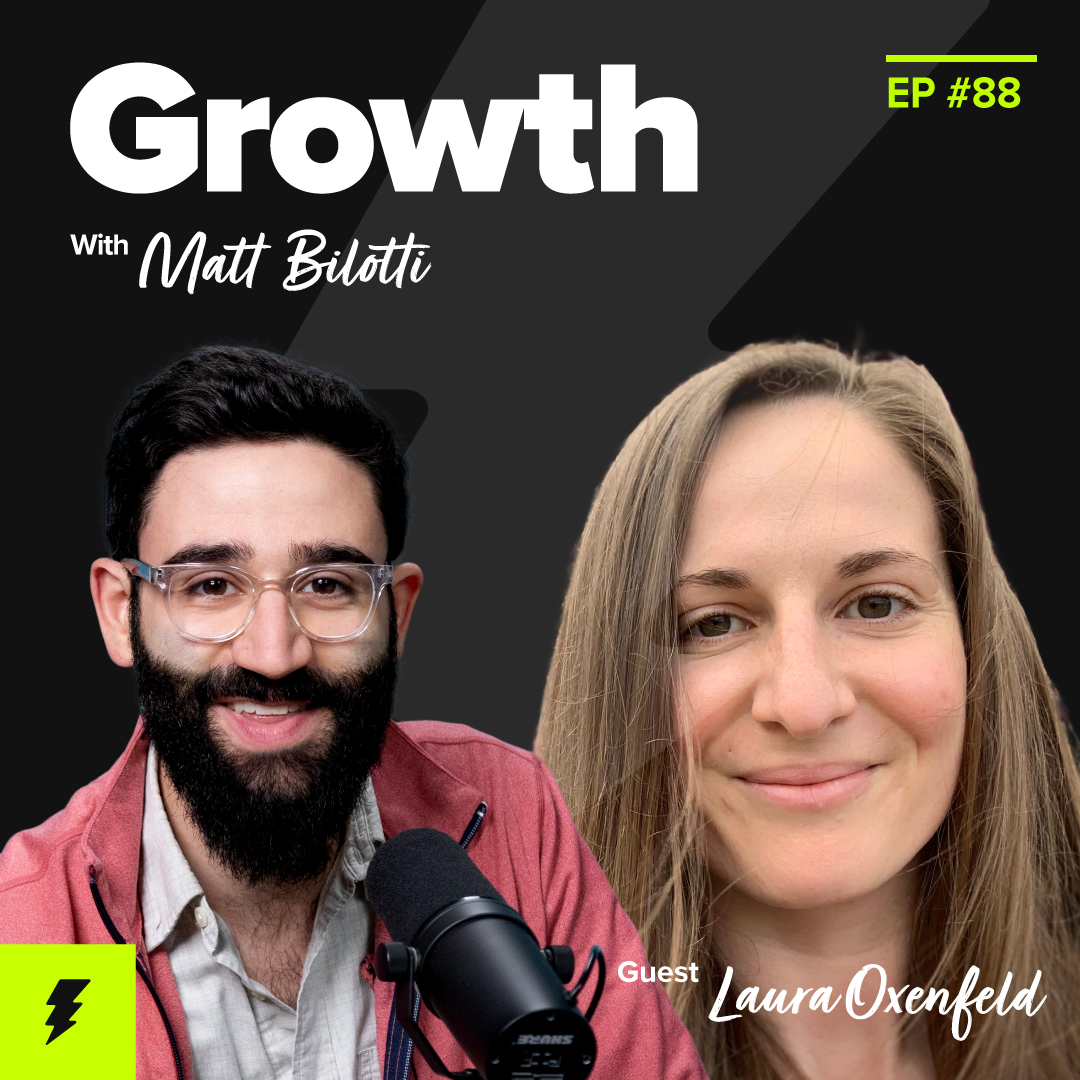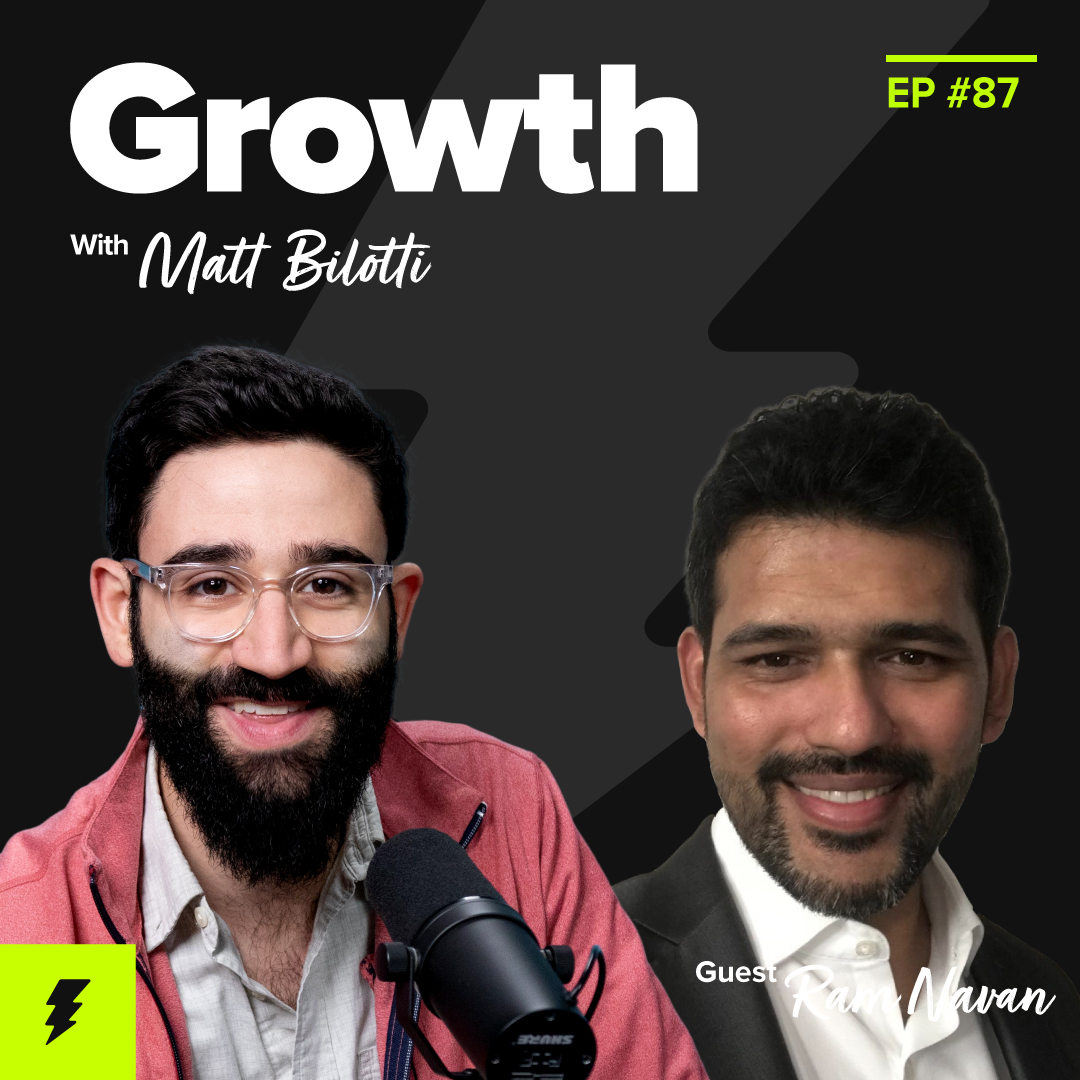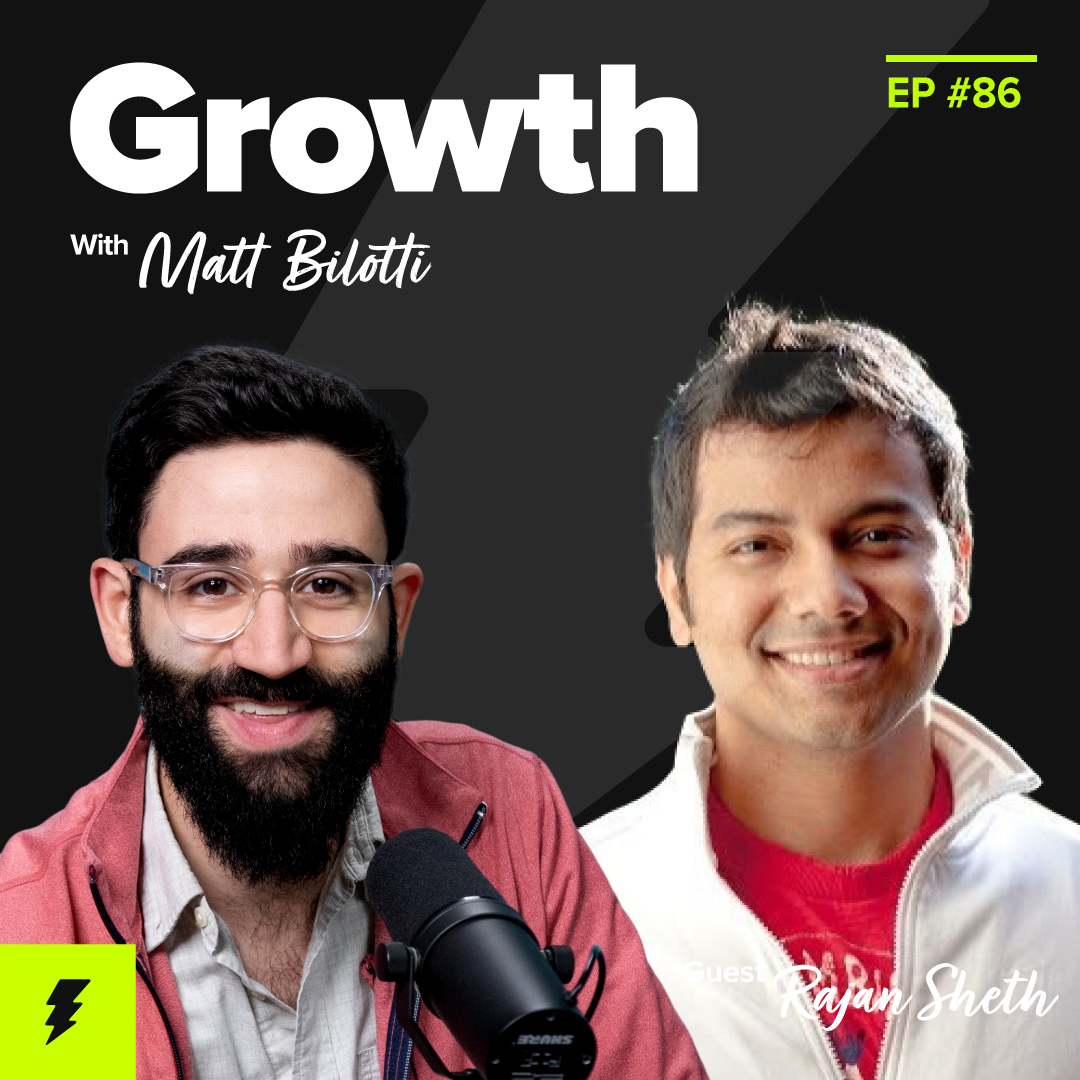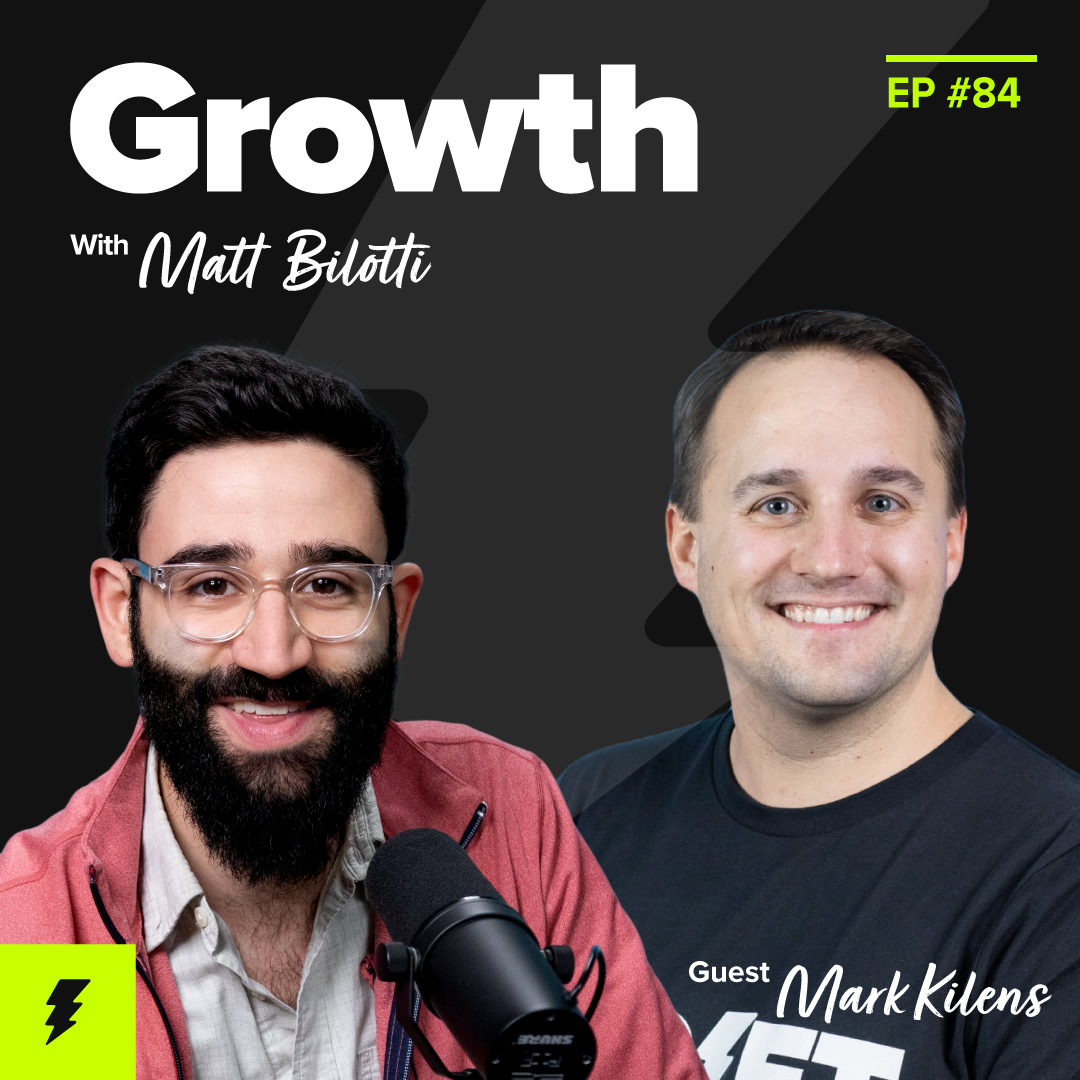The Secret to Unlocking More Growth at Your Company? Content. (w/ Julie Zhou and Shae Henrie, AdRoll)
- 0.5
- 1
- 1.25
- 1.5
- 1.75
- 2
Matt Bilotti: Hello, and welcome to another episode of The Growth Podcast. I am your host, Matt Bilotti, and I am super excited today to be joined by two folks. We have Julie Zhou, VP of growth at AdRoll, and we have Shay Henry, senior content marketing manager at AdRoll. Thank you both so much for being here today.
Julie Zhou: Happy to be here.
Shay Henry: Yeah. Thank you.
Matt Bilotti: Awesome. Well, I am excited for this because we have touched a couple episodes around content, but I think today is going to be a really good dive on how content and growth work together. Which is why we have both Julie and Shay here, to talk about both sides of the fence there, and how they work together. So the quick high level here is AdRoll has been primarily focused on retargeting type use cases in the past. And they have been working to break into new categories around marketing automation, through a whole bunch of different channels. And content is a core part of their growth strategy. And today, that's why I brought on both the growth person and the content person here. And we're going to talk about how they work together and all that. So, Julie, how about you introduce yourself first, and then we'll have Shay introduce, and then we'll go ahead and jump in from there.
Julie Zhou: Yeah. I am super psyched to talk about this topic. I have been working in growth for a little over 10 years now. I'd like to say I started working in growth before it was cool, and before it was actually called growth. And my team at AdRoll oversees all channels through which you communicate to customers in a scaled way. So if any of our customers and prospective customers don't have a dedicated account manager, or person that they talk to learn more about AdRoll, or to learn how to use the product, chances are you're hearing from someone on my team. So all of our paid ads, SEO strategy, website, emails, and in- app notifications and messages.
Shay Henry: Yeah. So my name is Shay. I've been in marketing for about seven years, a little over seven years. I've been everywhere from agency to freelance, to in- house, B2B, B2C. I've seen it, I've seen it all. And I'm excited about all of it because I think content marketing is really the foundation for a lot of marketing now. It's everywhere. And I think it's a key piece and that's what me so excited about these deep dives, and really diving in and understanding how content plays a large role in marketing strategy as a whole.
Matt Bilotti: Awesome. Well, thank you both very much for being here. So I gave a quick high level around the whole strategy and content thing at the start here. I probably didn't get it perfectly accurate. So maybe Julie, can you paint us the high level strategy that AdRoll is taking to enter a new category?
Julie Zhou: Definitely. A lot of people might not know this, but AdRoll has been around for over 13 years. And actually, I think it's all almost been around as long as Google has. It's pretty ancient as far as internet terms and internet companies go. And for almost as long as AdRoll has been in existence, it's been a retargeting solution, a point solution. And that's been because we are really, really good at it. And we almost never had to create demand, really, or create awareness of why you needed retargeting. It was just obvious. And so the way that we got business was tell people what retargeting is, and they would obviously want it. And that worked great for over a decade. But we started seeing limits to it. Retargeting is a point solution. It is a fraction of someone's overall marketing and overall advertising spend. And because it's such a transactional relationship, we're really only as valuable as the last click that we drive, the last conversion that we drive. So there's really no long term relationship we have with our customers. And so it made a lot of sense, especially given how much knowledge and data we had on how shoppers behaved online, and how to target shoppers at the exact right moment to apply all of that data that we had, our machine learning. A lot of companies talk about machine learning, we actually do it because we have so much data to work with to apply that to other channels. Not just advertising, but also to emails, and also to brand it, brand awareness campaigns. Like make someone's marketing, a whole marketing strategy way more effective. This is an expansion of our position in the market. So we needed to raise awareness of what it is that we did. We couldn't just say what we did and have it be obvious anymore. So we started looking for ways to grow our awareness of becoming a marketing automation solution, and content was a clear way to get started there.
Matt Bilotti: Yeah. It makes a ton of sense when you think about educating the market, and re educating your customers on the other services and things that you can offer. So I would love to maybe walk through, so company making the strategy shift, you're saying content is a big play here. How do you, on the growth side, plan out and align yourself with long term content strategy?
Julie Zhou: Yeah, definitely. So because AdRoll had basically zero brand awareness or authority in topics other than retargeting, we were starting with a blank slate. And I'll talk a little bit about how the content program got started, and then Shay can then talk about how we got smart with our strategy. Because I'll say at the beginning, we really had no long term strategy. We were just getting started. We had no idea what we were doing, except we knew that we needed to create good, compelling, useful content for our customers so they felt Goodwill. So that they would say," Hey, AdRoll has given me all this free great information about how to be a better marketer. Obviously I want to learn more about what kind of marketing solutions they offer when the time comes for me to make that decision." So since we were going from no content to some content, we definitely went for breadth rather than depth. We opened up our production lines from six pieces per month, and this was everything from blog posts, to interactive quizzes, to downloadable white papers, to interactive graphics. We went from six pieces per month to 50 per month within about two quarters. We went for volume.
Matt Bilotti: That is a leap.
Julie Zhou: Yes, we wrote on every possible to topic related to marketing that you could imagine. Including a lot of topics that AdRoll did not offer a solution for, like Instagram influencer marketing, because we knew that it was something that our customers were interested in. I would not recommend this as a long term strategy, but it opened up a huge world of possibility for us. Because we were offering so much more now to our prospective customers, we got a lot more upper funnel traffic that we could then nurture into future customers. The visits to our web properties from organic traffic went up 50% month over month. And kind of unexpected, our paid traffic as well. We had reached the limit of how much we could spend with our paid ads effectively because we were really only able to bid on keywords surrounding retargeting, and display advertising, and things like that, because we weren't known for anything else. And then all of a sudden we have this whole world of content that we're starting to get organic traffic for. And we ran, based on our initial tests and some analysis that we ran, our paid traffic spend potential doubled from one year to the other. Like how much we could spend increased by way, way more because now we're suddenly playing in a larger world really. And because we ramped up content production so quickly, we couldn't do it all from the content team or even from an agency. We ended up recruiting a lot of employees, including our CMO, even at the time, to write articles and to propose topics. And that had a really positive impact of employees, not only in the marketing team, but also in the sales team, also in the customer success team. Even the design teams, they got a chance to show off their expertise. And then they also felt bought into the success of the content program. We kind of skipped the whole phase of needing to make a case to invest in content because everyone already felt bought in.
Matt Bilotti: Yeah. I mean, that is a crazy leap of additional content to be pulling together. And it makes a ton of sense that it opened up all sorts of new opportunities. Shay, I'd imagine from your end, it sounds like a lot to coordinate and create, and all that.
Shay Henry: Yeah. I actually stepped in more recently after the large breadth and scale tactic for content. So I have to credit the team that was in place before who really grew that strategy, and knew that breadth and talking to our audience more broadly helps us learn about our audience better. What are you interested in? What are you engaging with? What could be our next offer for you educationally or from a product standpoint? How can we learn? So I think they just did a fabulous job. The other thing they did was create great page authority by talking about this for so long that we have the domain authority, and the keyword breadth to support talking about these different types of topics. So when I came in, you can imagine, at the production rate, how many pieces of content we have. And all I see there is endless opportunity. And that comes from looking at the under performers, the unicorns that we were surprised about, the ones that are doing just okay. Because now there's so much data that we know about the people who are consuming our content, who are taking action from our content, where they're going and what they're doing. It's untapped. There's so many things you can build from that and so much you can apply that to. Because after you learn that information, you can apply that to a paid strategy. You could apply that to an email marketing strategy, because it's just so valuable to know what's on people's minds when they're reading your content and interacting with it.
Matt Bilotti: Yeah. I can imagine that you're walking in and gold mines have been created and now you get to help explore and discover what's underneath.
Shay Henry: Exactly. And that's where I really love that depth. And I wanted to pull on a thread from one of Julie's comments and observations from creating that much content, is that our paid also had more potential. And that's why I think content marketing is really a base foundation in marketing is because it's so impactful across the board. Just the same way that SEO and organic social really have a lot of influence on each other. And similarly to paid and organic search and the way that people interact. As an organic person, I love organic, but paid, I can learn a lot faster. So that sharing of data and being able to pass that type of information back and forth, strengthens every part that we work on from that point on.
Julie Zhou: Yeah. And I mentioned before that what the growth team does is to communicate and engage with our customers and prospective customers at scale. If there's no content that we've created, I have nothing to say to them. So in reality, content and the types of topics that we've now focused on, and chosen to build long term authority through, it's the starting point for the growth team success.
Matt Bilotti: So would either of you say or recommend that breadth of content, paint the world strategy, is something that most places should pick up if they're moving into a new strategy, or is it kind of like, it depends on the context of the strategic shift? How would you frame that?
Shay Henry: You know, I think it depends on what you do. Because marketing is so broad. And we're speaking to marketers, but that like could mean any number of roles and leadership responsibilities and decision making. So when we're talking to marketers, we have the opportunity to go a little bit broader. And like I said, to inform what we do next. And solutions we offer, and what direction the industry is going. We can learn just as much from our customers as they can learn from us. So I think for us, it was the right move. We do know which parts we won't talk about anymore, and we're not going to continue to build on. And that's okay. It was an experiment that we did and we learned from it, and now we can move on. But I think that if you're a smaller business and you have a more focused offering, talking about your expertise and what you know, especially if you have a smaller team, is really a good place to start. Build the authority on what you already do, instead of trying to build that longer term vision right away. Until there's a certain point when you are starting to think about the next step, the next growth, the next service, the next offering, the next product, where you can start to assess the plan and go, how much wider are we going to go with strategy and offering?
Matt Bilotti: Yeah. So I would love to, let's step through this a little bit. So Shay, you're coming in, there's all this stuff here and now you're looking at it like, how do we scale, how do we drop the things that weren't working and is not useful for Julie's teams? What is the mindset? How do you carve your way through the future?
Shay Henry: Well, the first was to align of, what do we really want to be known for? And we have to track back to what we offer. We have to track back to the difference we can make in retargeting brand awareness. Everything that we offer, we got to be authorities there first. So really that's where I started on that deep dive. I started with those gold mines because they're the largest, and they're the most well built out. There's a lot of content around this already. And with this massive amount content, I didn't want to come in and say,"You know what we need? More content. Let's create it." I just didn't think that, that was very smart because there's so much untapped content there that what can we optimize? What can we cut and get rid of that extra weight, and bring our focus in a little bit more? Where can we combine? Are we talking about things in two different ways where we can really solidify the voice, and really take a hard thought leadership stance on, and make a very solidified and clear plan, or clear message for somebody? So that's where I started, was track back to what our expertise, what we do, we are experts in. But then from there is identifying what we might want to do in the future, and that's taking cues from what we've learned. What additional things are people engaging with us on. If they find us authoritative on organic social, then let's continue talking about it, and let's continue to foster a community for it. So we can have that shared back and forth between us and our customers. And then that's how you kind of establish that secondary tier of content you want to create.
Matt Bilotti: Yeah. It sounds like there are just so many opportunities to take what is working, double down on it. How do you, and maybe Julie can jump in on this piece as well, but maybe give us a little bit of the tactics of, how do your teams work together? Like, Shay, is your side creating inventories of all the content. Julie, are you showing up and saying, here are the things that we're thinking about running, can you help us fill in the gaps? Yeah, maybe walk me through something around that.
Julie Zhou: Yeah. I'll start off on this and Shay will have a lot to say, because as you imagine, this is a very collaborative experience. So we start with looking at all the content that we've created thus far, because as we've set the scene, we have written about basically everything under the marketing sun. We look at what has performed well, and we relate that to our product roadmap. What's coming, what's available now, what's coming in the future? And also what is most valuable and usable and popular with our customers now. So, the AdRoll platforms offers a ton of marketing automation features. From running retargeting campaigns to brand awareness campaigns, to running email campaigns, to running onsite optimization, email capture, all of that. The different products are in different stages of readiness, and also different stages of adoption by customers. So my team will interface with the product team to really get intel and insight on like, hey, which of these new features seems like it's sticking the most? And ideally we map that back to topics that we've written about. And based on Shay's analysis, ideally those topics we've written about, we've also gotten a lot of engagement with. And in this case, it did match up in which that not only did we gain a lot of traction with our retargeting product that we had for years, but we're starting to gain a lot of traction and interest in brand awareness. And so that was really a topic that both my avenues of research and Shay's avenue of research called out as a key tent pole topic that we should build a whole, our next strategy around.
Shay Henry: Yeah, exactly. And like Julie said, this is so collaborative. So I don't think about creating a piece of content until I've talked to the teams who would be involved in the research and distribution. From end to end, I don't start a project unless I know how all of those things are going to go. So we need to collaborate, share data with the growth team, Julie's team. Understanding product motivations, understanding positioning. Everything that's happening, what's happening across multiple teams, and then start to craft my content from there and the content that we create. And there's a whole team that's really dedicated to the success fully of each piece, and understanding what success for each piece looks like. Because a top funnel engagement piece that I want to be shareable and engaging, and drive a lot of traffic, I'm not going to set to convert. That doesn't make any sense to have any strongly tied conversion goal for a top funnel piece. So that motivation and knowing that, then what social channels does it go on? I have to talk to our social team and understand where they're going to put this piece of content and map it across the board. So it's really from beginning to end, we're collaborating throughout the process from research all the way back down to analysis.
Matt Bilotti: Yeah. I love the whole, set clear success criteria with anything that you take on ahead of time. Because otherwise you can have a situation, like when I jumped into this conversation here, I was picturing like, okay, they're working together on stuff and they're just making a ton of content, then growth picks it up and finds ways to use it in different channels. But you're saying it's like way more methodical now. Because you're kind of done with the phase of just do all this stuff and now it's, we will only do things, or we will only like gather certain existing pieces of content if we know what we're going to get out the other end.
Julie Zhou: Yeah. And at the end of the day, any tent pole topic that we pick has to allow for bottom of the funnel lead gen content. It has to allow for, I think Shay you call them magnets, right? I would call them downloadable assets, that we could feel really good about presenting as a piece of gated content that prospective customers can download. That we would feel good about handing to our sellers. That sellers would get excited about offering to people that they're trying a cold call, or people that they're trying to build relationships with because they know that content will actually be super valuable to them. And the topic on brand awareness, check all those boxes.
Matt Bilotti: Cool. How about we jump into a couple examples, that way some listeners can really anchor themselves and stuff. So, yeah. Maybe let's start with a first example of what all this looks like in action.
Julie Zhou: Yeah. Let's take brand awareness there. Shay, you saw that there were some blog posts that were super, super popular, and also happened to be related to this. I think you got a lot to say there.
Shay Henry: Yeah. So Julie's team actually provided me with so much data, so many metrics on our blog posts when I started. And I just got to dig in and see, what about these pieces? What are they doing? What are all their different metrics? And why do I think that they're performing in such ways? Where have they been marketed? Are they currently in use in a larger campaign? And one of the things I noticed that really started to stand out was brand awareness. To Julie's point, that started to really come up for me as I was digging through our Google search console. I'm seeing a lot of indications that brand awareness is getting a lot of impressions, but leaves room for desire on clicks. I want more clicks out of this. And one of the things that came up was a blog post, we wrote it back a while ago as you can imagine, called, How Brands Are Revamping Their Logos and Taglines During COVID- 19. And that had a lot of traction. And interestingly enough, still gets quite a few new users and traffic each month still, to this month. And I'm thinking, wow, how can we continue to capitalize on that? That's no longer timely and relevant because we're not really in the middle of a pandemic anymore, but clearly something is still resonating if it's still getting users in traffic. So let's build on that. That's a really easy thing that we're seeing a lot of queries for leading to our site. We have a lot of existing content around already so the authority's there, but how do we now improve the quality of the leads coming through from these pieces?
Julie Zhou: And honestly, that blog post that Shay is referring to, it was a fluff piece. Someone on the marketing team thought it would be fun to do. There's no success metrics around it. She just thought it would be cool. And so she championed for it, helped write it. And then all of a sudden it ends up being this key piece to figuring out the rest of our strategy. So that goes to show, when at first you don't know where your focus is going to be, it is important to allow yourself the freedom to just go broad.
Matt Bilotti: Yeah. Even from the product side, one of our most successful growth type things that we did for our Drift video product in the early pandemic was one of the engineers was like, thought it'd be nice to make this is Zoom integration thing that nobody had really planned for. There were no metrics around it. And I don't remember, maybe it was right before the pandemic started, but it became this super important part of our strategy moving forward. So I love examples like that. Most of the time you need to be really thoughtful about your resources and what you're going to bet on, and what the outcome's going to be. But in some cases it's good to leave a little bit of creative space to find those things that just were like, oh, we couldn't have come up with that with our normal process.
Shay Henry: Yeah, exactly. And it turns out to not be as scary of a bet. Because we went for that breadth and we took a little bit of the risk a while ago, to build this type of authority around marketing more generally, is now the bets are not as big. I already know brand awareness is starting to perform for us. It accelerated our learning to be able to speak as broadly as we did.
Matt Bilotti: I would love, maybe one or both of you, some thoughts around, if somebody's listening to this and they're saying," All right, we have like a loose content strategy." Or they're saying," Well we're trying to figure out our next big growth channels and this approach of breadth and content, our investors are telling us to go do content as a core strategy." I think a lot of people are just what the next steps there look like for either taking some content, existing base, or making a brand new bet on content as a growth channel. What would you say to those people as they're framing their own decisions around it?
Shay Henry: I think it does depend on your stage, and where you're at and what you're offering and what your team looks like. But I would say the best thing that you can do is to not work in silos. Don't throw your work over the wall. If you have a content strategy and you have a content team that's working with a strategy, or they're validated in their data and they know they're making good decisions, and then you have a growth team who's doing that separately, all you have to do is open the channel of communication. And then together comparing data and finding these spots where we go," Oh, we both found this thing." Then it's easier to justify larger bets that span larger, bigger projects, because now you have two teams validating what you think you should do. So I would just say, in any content strategy, open up communication channels and start talking it out. And you'll probably find your strategy is easier to identify than you think when you really look at all of the data together.
Julie Zhou: Yeah. Plus one to everything that Shay said. I would advise teams not to think about content as a point solution, or as a single line item strategy. You don't do content for contents sake, unless you are literally a content company. Content is the way through which you have something to say to your perspective customers. It's the mechanism by which you give something of value to people that you hope will one day spend money back with you. If you already know everything you need to say to your customers, if you're already saying it, if you've already built Goodwill with all the people that you want to, and then there's no, you don't have to do more content for content's sake. We started truly investing in content because needed to expand. You probably want to do content if you want to do something similar, right? If you either want to shift the focus of your strategy, or you want to grow market share, or you want to do basically something different than what you're already doing.
Matt Bilotti: Love that, that is a great, both of you, great points. I will keep that in mind for my own stuff in the future, for sure. Cool. Anything else that you want to touch, on either of you want to touch on, that we didn't get a chance to cover in this as parting words before we wrap up here?
Shay Henry: I think what I would say, just to really recap what the overall theme for me in content marketing is, is that content is king in context. Marketers hear all the time, content is king, content is king, content is king. And I'm so done hearing that. Because it just assumed that all you have to do is create. That it's okay to just go for it. And a broad strategy is one thing, but creating without purpose is another thing. So just make sure that context is always in mind. What would your end goal be in creating a broader content strategy? Would it just be to rack up a bunch of keywords, or is it because you actually have intention on creating content that is helpful and actionable to the people who want to read it? And it makes sense for you to even be saying it. So making sure you understand the context in which you're speaking yourself. That's really the general idea. It is all about establishing that context.
Julie Zhou: Yeah. Quality over quantity in the long run. Like quantity first is fine to get started, and I would highly recommend it if you don't know where it is that you want to focus. But if you are leading content strategy, you have to have very strong conviction around when the time comes to change to a more focused quality strategy. Because a reader can always tell if a piece of content is written for SEO purposes, like purely for SEO purposes. And it'll just turn them off. So there's absolutely no need to maintain content quantity just for the sake of quantity in the long run.
Matt Bilotti: Yeah. Yeah. And even just thinking back to early days of Drift, we went really hard on quantity of content as we were figuring out what our market was, and what our value prop was, and what our language was as a brand. And then we found that perfect point where we hit it with people, and they were sharing our content all of a sudden, super excited about it and stuff started to take off because we found the thing and the moment. But it was the quantity that got us there, and now it's quality that carries us forward.
Julie Zhou: Yeah.
Shay Henry: Exactly.
Matt Bilotti: Cool. All right. Well, thank you both so much. This has been a wonderful conversation. I love having both sides of a story and of a team. It sounds like the crews over there work very collaboratively. And I know people listening that are thinking about content in any sort of way had plenty of take aways. Thank you both for joining us.
Julie Zhou: Thank you for having us.
Shay Henry: Yeah. Thank you.
Matt Bilotti: Absolutely. So for those of you listening, thank you so much for tuning in. If you haven't heard The Growth Podcast before, make sure to hit the subscribe button, check out the other episodes. I think there's 80 something of them to check out with other amazing growth experts that go into deep dives around certain channel strategies or tactics. If you're a fan, five star reviews go a really long way, written reviews go even further. And I would super appreciate those. I know at the end of the day, you have so many things to be working on, listening to, watching, doing, whatever it is, and the fact that you're spending here listening to the podcast is something I will always be the thankful for. So appreciate that very much, and I will see you on the next episode. Thanks.
DESCRIPTION
AdRoll, a digital marketing and growth platform, has been a player in the retargeting space for 15+ years. But a few years ago, the company realized it needed to branch outside of just the retargeting category in order to build long-term relationships with its customers. This led to one big, looming question: how was Adroll supposed to enter a new category after spending such a long time playing in one space?
The answer: content marketing.
Julie Zhou, VP of Growth at AdRoll, credits a content strategy focused on breadth, instead of depth, to AdRoll's expansion success. Through this strategy, Julie's team was able to figure out what content resonated with their customers and how to engage prospects at scale.
On this episode of Growth, Julie and colleague Shae Henri (AdRoll's senior content manager) join Matt to talk about what the process behind a broad content strategy looked like, how they narrowed it down as they figured out what content resonated, and why product, growth, and content teams should always be in lockstep.
The Notes:
(1:12) Introductions
(2:42) The high-level strategy AdRoll has taken to enter a new category
(5:39) How AdRoll’s growth team aligns itself with a long term content strategy
(9:29) How Shae audited AdRoll’s content to squeeze more out of it
(14:29) How Shae carved her way to the future of content at AdRoll
(16:37) How Julie’s and Shae’s teams work together
(21:23) A real-life example of how Adroll’s content and growth teams worked together to drive results
(25:09) Advice for people just starting to think about content as a growth channel
Like this episode? Leave a review!
Today's Host
Matt Bilotti
Today's Guests
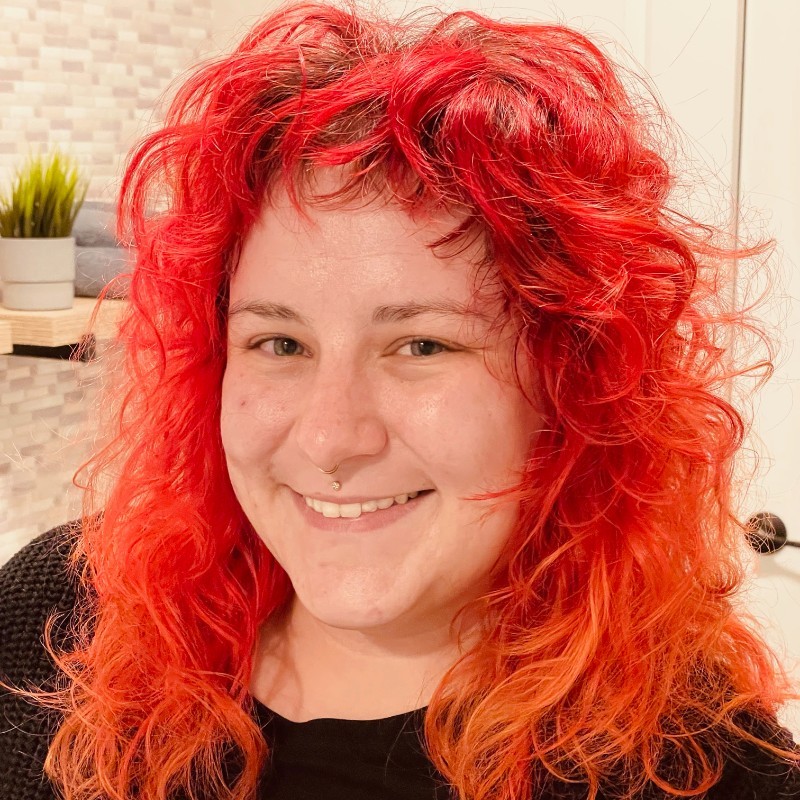
Shae Henrie


